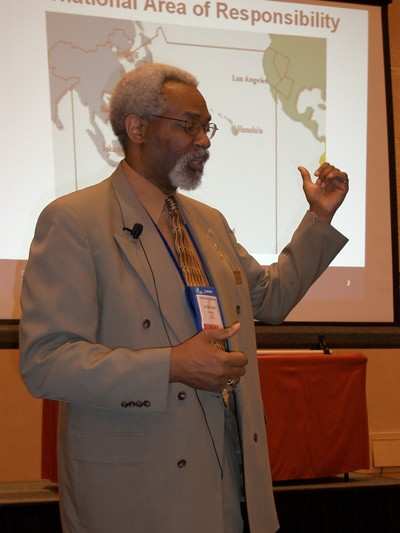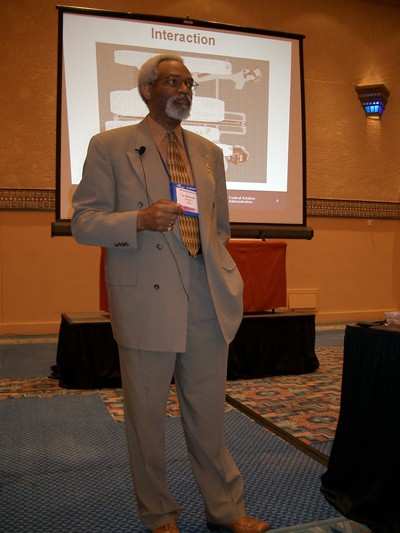WAI Panel Held For Those Who Don't Fly
 Runway excursions are one of the
FAA’s pet peeves. Pilots are not the only ones involved...
line service workers and mechanics are also responsible for moving
aircraft to and fro on an airport surface.
Runway excursions are one of the
FAA’s pet peeves. Pilots are not the only ones involved...
line service workers and mechanics are also responsible for moving
aircraft to and fro on an airport surface.
At this weekend's Women in Aviation conference, Dr. Paul Foster,
Jr. presented a forum on runway safety, for those who don’t
fly. Foster maintains mechanics move more planes than pilots. ATC
counts flights, but not surface movements.
"In the morning when the crew shows up to the terminal, how did
the aircraft get there?" Foster asked. "Maintenance brought it
over. Last flight of the night who takes the aircraft to the
hangar?"
One of Foster’s first suggestions is that pilots talk to
their mechanics. "That aircraft there that they’re taxiing
belongs to you. You want to protect it." Foster warned the pilots,
the plane that is taxiing in front of you could have a mechanic
behind the yolk, who may not be as familiar with signs and markings
as you.
According to Foster, most of the schools he's been to are not
teaching signs and markings to mechanics -- they are teaching light
gun signals. When is the last time the tower gave light gun signals
to a tug? This trend seems trend seems to be changing for the
better, with some schools spending days on signs and marking.

The good news Foster imparts is there have been "no deaths from
mechanic-led incursions."
"We have already learned to drive on the airport when we drive
on the street," reminded Foster. "Some of the same markings mean
the same things, with a little additional definition." Solid yellow
lines mean don't cross, on the highway and on the airport; dashed
lines, Foster said, mean "dash across."
At night, if there are green lights along the center of the
taxiway, side lights are not necessary. The theory is, if you stay
on the center line lights you are clear of the runway edge, so it's
a good idea to follow those center line lights. "Be vigilant,"
warns Foster, as pilots have had tendencies to land on
taxiways.
Foster explained the two types of areas on the airport surface,
movement and non-movement areas. In non-movement areas, vehicles
can move without talking to air traffic control. In movement areas,
ground vehicles must talk to ATC. Clearance to taxi to an area does
not give you permission to taxi back to your starting point. It's a
one way ticket, not round-trip.
All conversations with ATC are recorded, so "be careful what you
tell us (FAA) what you said," warned Foster.

Surface incidents are what the incidents are called until the
results come back from Washington DC. Once back from DC it may then
be called a runway incursion. A surface incident is defined as "An
event where unauthorized or unapproved movement occurs within the
movement area or an occurrence in the movement area associated with
the operation of an aircraft that affects or could affect the
safety of flight."
If a surface incident is classified as a Runway Incursion, it is
assigned a severity category. Category D means little or no risk of
collision. Category C means ample time and distance to avoid
collision. Category B means significant potential for airplane
collision. Category A means barely-avoided collision.
Foster also told a bit of trivia as to how the distance of
hold-short lines came about, and why we need to stay behind
them.
The NTSB, FAA and several other alphabet groups got together.
Measurements were taken of each piece of debris when airplanes
crashed on the runways -- including jumbo jets, corporate jets and
small props. Foster told his audience generally for the airliners,
250' was the maximum distance of debris spread, so larger airports
have their hold-short lines set 250' back from the edge of the
runway. At smaller airports, hold-short lines will be closer to the
runway.
Signage once again mimics driving. Mandatory signs, like a stop
sign are white letters on red background. Informational signs are
black letters on yellow background, location signs are yellow
letters on black background. Some airports use surface painted
signs. These surface painted signs are used on hot spots on the
airport to supplement existing signs.
Maybe considering the whole airport surface a "hot spot" is a
good idea.
 ANN's Daily Aero-Linx (04.16.24)
ANN's Daily Aero-Linx (04.16.24) Aero-News: Quote of the Day (04.16.24)
Aero-News: Quote of the Day (04.16.24) Airborne 04.10.24: SnF24!, A50 Heritage Reveal, HeliCycle!, Montaer MC-01
Airborne 04.10.24: SnF24!, A50 Heritage Reveal, HeliCycle!, Montaer MC-01 Airborne 04.12.24: SnF24!, G100UL Is Here, Holy Micro, Plane Tags
Airborne 04.12.24: SnF24!, G100UL Is Here, Holy Micro, Plane Tags Airborne-Flight Training 04.17.24: Feds Need Controllers, Spirit Delay, Redbird
Airborne-Flight Training 04.17.24: Feds Need Controllers, Spirit Delay, Redbird





